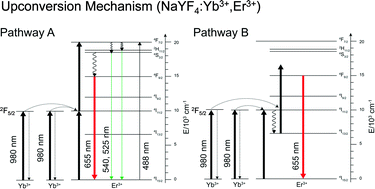The preferred upconversion pathway for the red emission of lanthanide-doped upconverting nanoparticles, NaYF4:Yb3+,Er3+†
Abstract
Lanthanide-doped upconverting nanoparticles (UCNPs, NaYF4:Yb3+,Er3+) are well known for emitting visible photons upon absorption of two or more near-infrared (NIR) photons through energy transfer from the sensitizer (Yb3+) to the activator (Er3+). Of the visible emission bands (two green and one red band), it has been suggested that the red emission results from two competing upconversion pathways where the non-radiative relaxation occurs after the second energy transfer (pathway A, 4I15/2 → 4I11/2 → 4F7/2 → 2H11/2 → 4S3/2 → 4F9/2 → 4I15/2) or between the first and the second energy transfer (pathway B, 4I15/2 → 4I11/2 → 4I13/2 → 4F9/2 → 4I15/2). However, there has been no clear evidence or thorough analysis of the partitioning between the two pathways. We examined the spectra, power dependence, and time profiles of UCNP emission at either 980 nm or 488 nm excitation, to address which pathway is preferred. It turned out that the pathway B is predominant for the red emission over a wide range of excitation powers.


 Please wait while we load your content...
Please wait while we load your content...